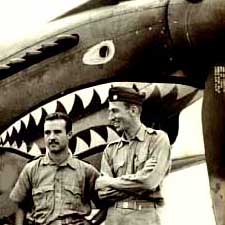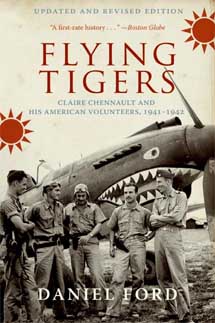| Flying Tigers |
 NH BOOKS
NH BOOKS
Durham, NH author Daniel Ford didn’t make the pilots of the Flying Tigers happy with this book first appeared in 1991. Ford’s research showed that the elite volunteer air force shot down fewer than half the Japanese fighters officially recorded in 1941-42. The true story of this heroic team, however, is even more amazing than the legend.
FLYING TIGERS:
Claire Chennault and His American Volunteers, 1941-1942
HarperCollins History
Trade Paperback, $15.95
BUY THIS BOOK from the author
An eyewitness, police investigators often note, can be the least reliable source of information. It isn’t that they lie. It’s just very difficult to know what is going on when you are in the middle of the action. Frightened young American pilots meeting an enemy plane at a combined speed of 700 miles per hour through the clouds in combat did not always get their facts straight. When the US government claimed nearly 300 "kills" of Japanese fighter planes over Rangoon, China in 1941-2, it may have stretched the truth. Others suggested the figures were certainly more, maybe twice as many or even over 1,000 planes downed. Decades later, following a meticulous study of the records, historian Daniel Ford puts the actual number at 115.
 Daniel Ford first learned about the Flying Tigers from a novel when he was a teenager during World War II. He is best known for his 1967 novel about the Viet Nam War entitled Incident at Muc Wa. That was translated into the film Go Tell the Spartans starring Burt Lancaster, that came out in 1968 while the war was still raging. He has been a full time writer ever since and lives in Durham, NH. He got his pilot’s license at age 64 (and is now 75)..
Daniel Ford first learned about the Flying Tigers from a novel when he was a teenager during World War II. He is best known for his 1967 novel about the Viet Nam War entitled Incident at Muc Wa. That was translated into the film Go Tell the Spartans starring Burt Lancaster, that came out in 1968 while the war was still raging. He has been a full time writer ever since and lives in Durham, NH. He got his pilot’s license at age 64 (and is now 75)..
When his book Flying Tigers appeared in 1991, surviving members of the elite private flying force wen ballistic. In one case, Ford points out, two American pilots shared a bounty of $500 for killing a Japanese pilot who was still alive. Ford interviewed the Japanese pilot and the two men who claimed to have shot him down.
Historians don’t set out to make people angry or unseat heroes or embarrass governments. They set out to tell the truth. At least, that is what good historians do. Ford has been criticized for comparing Japanese military records with the "official" records of the Chinese and Americans. But when some sources claim more planes downed than were actually built, the historian, the good historian, looks at all the facts.
The heroism of these volunteer pilots is not in question. The secret air force, sent to defend China prior to the official American entry into World War II, accomplished amazing things. But the legends surrounding the story loom larger than the facts. What Baby Boomer boy did not build a model of the Flying Tiger planes with its grinning shark mouth exposing deadly sharp teeth? The planes and the general arc of the story are true. A great many Japanese fighters were defeated with relatively few American casualties. But as Ford points out, the heroes were well paid, as much as $144,000 per year of service in current dollars. And they didn’t always do exactly what they thought they did.
In this second edition of his "revisionist" history masterpiece, Daniel Ford tightens up the tale, corrects a few errors, and adds dramatic new details. But he does not back down against critics who prefer the legend to the truth. And he does not believe, that the truth diminishes the stirring events, but only makes them more human and exciting. -- JDR on SeacoastNH.com
FROM THE PUBLISHER:
During World War II, in the skies over Rangoon, Burma, a handful of American pilots met and bloodied the "Imperial Wild Eagles" of Japan and in turn won immortality as the Flying Tigers. One of America's most famous combat forces, the Tigers were recruited to defend beleaguered China for $600 a month and a bounty of $500 for each Japanese plane they shot down—fantastic money in an era when a Manhattan hotel room cost three dollars a night.
To bring his prize-winning history of the American Volunteer Group up to date, Daniel Ford has completely rewritten his 1991 text, drawing on the most recent U.S., British, and Japanese scholarship. New material from AVG veterans—including Erik Shilling and Tex Hill—help fill out the story, along with newfound recollections from Japanese and New Zealand airmen. Ford also takes up the rumors that Royal Air Force pilots "sold" combat victories to the Flying Tigers in order to share in the bounties paid by the Chinese government.
"Admirable," wrote Chennault biographer Martha Byrd of Ford's original text. "A readable book based on sound sources. Expect some surprises." Even more could that be said of this new and more complete edition.
